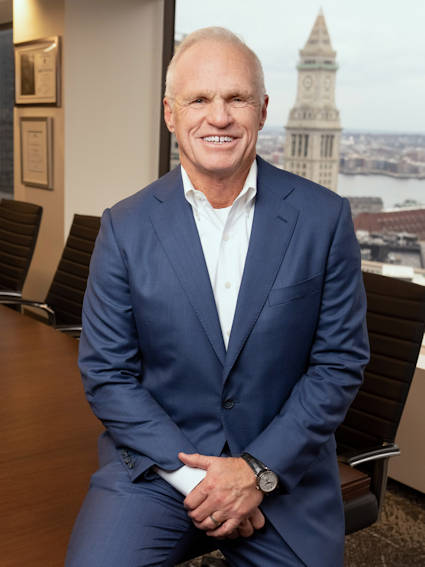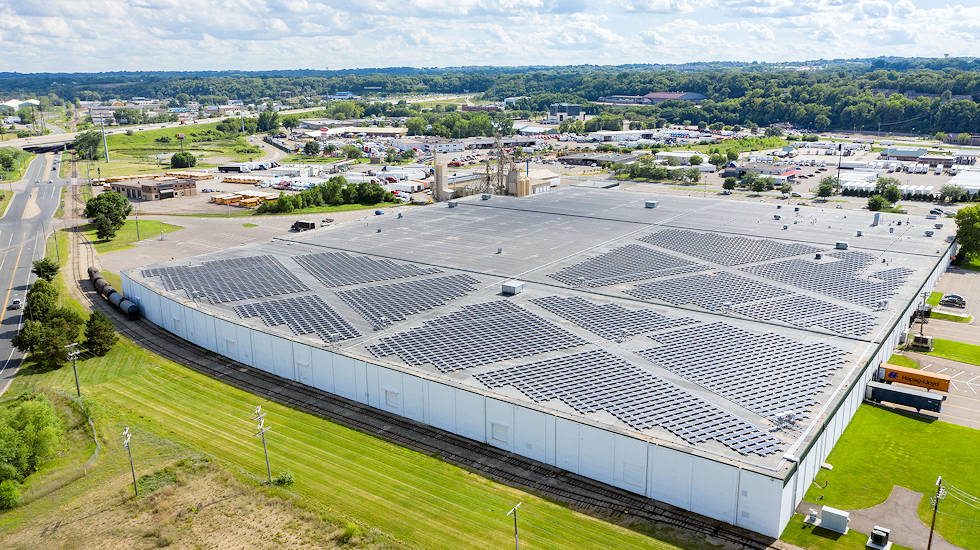Few real estate companies can say they weathered the COVID-19 pandemic unscathed, but with approximately 40% of its assets supporting some level of e-commerce activity, STAG Industrial, Inc. (NYSE: STAG) benefitted as homebound consumers accelerated their online purchases.
Boston-based STAG, shorthand for Single Tenant Acquisition Group, celebrated a decade as a public company in 2021. The REIT has grown into one of the country's largest owners and operators of industrial real estate, owning more than 103 million square feet in more than 500 properties across 40 states. To lower risk, STAG operates in upwards of 60 markets and 45 industries, where each of its tenants—which include Amazon and FedEx Corp.—account for less than 4% of revenue.
This is a big change from the private equity real estate portfolio that President and CEO Ben Butcher took public in 2011. Back then, it had just 14.2 million square feet across 26 markets. Flex and office space filled about one-fifth of the space, compared with just 0.3% now. In terms of equity market capitalization, the change is striking: It was $290 million then, compared with more than $7.5 billion now.
STAG recently announced that Butcher is expected to step down as CEO and become executive chairman on July 1.
REIT magazine spoke with Butcher about STAG's view on market analysis, operating in the 'new normal,' and where he hopes to travel next, among other issues
What makes STAG unique among industrial REITs?
The biggest differential to investors is that we don't focus on development. Our degree of uniqueness is probably derived from our devotion to agnosticism.
We avoid, for the most part, the use of 'decision rules' in our investment decisions and in developing our corporate strategy. We believe that maximizing future cash flow is our primary responsibility and that virtually everything that will affect future cash flows can be analyzed.
It follows that such analysis is always preferable to utilizing decision rules. Remember that the world is not black-and-white, it is shades of gray. Many of our competitors will utilize an investment rule such as 'only buy in the top X markets'. In doing so, they are essentially saying 'the asset located in the X+1 market is not worth consideration at all.' Does that make sense? We look at assets in all the fungible U.S. markets—around 65 individual markets with a minimum of 28 million square feet of fungible industrial product.
In our view, market 'X' isn't good and market 'X+1' isn't bad, they are just different, and these differences can be accounted for in our analysis. Other decision rules employed by some of our competitors include minimum lease term, minimum tenant credit rating, and building age.
Who do you consider your competitors?
On acquisitions, we compete with all manner of equity capital from sovereign wealth funds to individual investors. Because of our focus on individual asset purchases, where there is less competition, we primarily compete with regional real estate private equity and individual investors. On leasing our owned assets, we compete with the other industrial owners' new and existing product.
In terms of who we compete with for investor dollars, it is the other public REITs, with First Industrial Realty Trust, Inc. (NYSE: FR) probably being the closest peer. Because of our focus on growing externally through acquisitions, none of the other industrial REITs is really a direct peer due to their focus on growth through development.
What are some of the topics you are discussing with your tenants?
They range from building expansions to sourcing additional space across the 60-plus markets in which we operate, and sustainability-related upgrades, such as efficient lighting conversion. These themes were highlighted in our recently completed fifth annual tenant survey. Tenants are looking to enhance the resilience and strength of their supply chains as well as to support new growth initiatives, although labor availability remains a concern and a limiting factor in these efforts. The majority of respondents indicated e-commerce activity has increased over the last 12 months, consistent with the belief that there has been a structural change in consumer behavior. The survey also revealed a noticeable increase in the importance of sustainable building operations as a measure of overall building fit.
How did STAG navigate the pandemic?
Surprisingly well. After some initial disquiet about operations and capital markets, the industrial market fundamentals took off—driven largely by the rapid uptake in e-commerce and supply chain issues. Going to 100% virtual was a pretty easy step for us. I have been a bit surprised by how readily corporate culture has been maintained.
Has STAG changed in the 'new normal'?
The realities of the new normal were becoming evident pre-pandemic; the last two years have served to accelerate in-place trends. Work from home was already a vibrant topic and now is a given in order to be a competitive employer. The question now is 'how many days in the office?' 'Work from anywhere' is now the new frontier. One thing I am convinced will not work going forward is mandating time in the office. To the extent that we, as managers, believe that employees' time in the office will benefit the company (and the employees), we actually need the employees to see how time in the office benefits them. Our office space may end up being considered just another benefit we offer to our employees.
How has the surge in e-commerce shaped your business model?
We remain focused on serving our existing and potential customers' needs and maximizing our cash flow in doing so. Our underwriting methods readily assess current conditions as well as periods where tailwinds such as e-commerce are not as evident.
The current and projected market rent growth allows us to acquire assets at lower initial cap rates and still maintain our return thresholds for cash flow over time. Our existing portfolio, primarily assets located around the perimeter of population centers, is and will be a part of the e-commerce supply chain going forward. There is e-commerce activity in over 40% of the buildings in our portfolio.
What's next for industrial real estate?
Sustainability progress and operational efficiency improvement through artificial intelligence (AI), predictive analytics, and digital connectivity. There is a lot going on in what has been a very staid industry for decades, a lot of low-hanging fruit.
What is the biggest opportunity and challenge facing STAG?
We are fortunate that our strategy of focusing on pricing inefficiency in the industrial market and taking advantage of that inefficiency to buy individual assets accretively appears to have plenty of runway, with our sweet spot in the $5 million to $30 million range.
To buy the $1.1 billion to $1.2 billion that we're projecting to buy this year, we're having to look at more assets or underwrite more assets to get to that number. That really focuses us on execution. The U.S. industrial real estate market is over $1 trillion, and STAG's share of that is less than 1%, so there's a lot of potential for continued external growth. The biggest challenge will probably be continuing to identify, hire, and retain the kind of excellent employees that have driven our success to date.
What are the current design trends for industrial real estate?
Sustainability in design, such as LEED certification, and lower net energy consumption. Carbon capture concrete is getting some attention. New construction continues to both get taller, in the form of clear height, and shorter, in terms of mezzanines/floors within tall buildings to allow more 'human scale' interaction between product and employee. This 'human scale' interaction is still necessary to make sure that what you order online gets in the right box and sent to you in a timely fashion. Increasing reliance on robotics and AI will continue to change how warehouses are operated in the future.
How can the REIT industry improve diversity in its top ranks?
There are likely few short-term fixes as we attempt to balance diversity and effectiveness. There are simply too few qualified candidates and tremendous demand for those that exist. The best answer may be developing diversity candidates from the ground up by hiring and training. This will take some changes to existing practices. One thing that we preach is that a 'good enough' candidate today may be a better long-term employee in terms of their attitude, energy, and loyalty than the 'best' candidate available during the interview process. This allows us to consider a broader range of potential hires and will, I believe, produce a better work force over time.
How is STAG adjusting increased calls for ESG reporting?
We view ESG reporting as something that you simply need to do to be relevant for most investors. We have been doing ad-hoc reporting of various initiatives across all three components for years. I am proud to say that the team has pulled updated reporting together in our inaugural sustainability report that will be published shortly. Our achievements in this area are worth noting. In fact, we recently received our 2021 GRESB Public Disclosure letter grade rating of B. Our score is above the REIT average and ranked second of the 10 industrial real estate companies scored by GRESB.
What do you do for fun when you aren't a CEO?
I play golf, hike, and travel with my best friend and bride, Linda. I read a combination of fiction and non-fiction—a book a week at least. I also enjoy spending time with our dog, Cali. This is my first time having a dog—I had cats as a kid—and the 'unconditional love' thing is true.
What advice would you offer to your younger self?
Looking back there are certainly decisions that could have been better made. I am proud that, in my career, I wasn't afraid to take chances, to explore ideas, and opportunities. I would tell my younger self that there is more time than you think to do those 'riskier' things and still end up in a good place. One thing I tell all 20-somethings who seek advice is to travel while you can. It will never be easier for them than it is right now.
Where was your favorite trip and what's on your bucket list?
I have made two trips to New Zealand and can't wait to go again. One individual trip stands out from earlier in my life. I went to the 1992 Summer Olympics in Barcelona as a guest of Sports Illustrated. I had amazing access to both athletes and events in a magical city. We even got to ride on the bus to a game with the original 'Dream Team.' There is still so much to see and do. Portugal is next. It is the only country in western Europe that I haven't visited yet.

